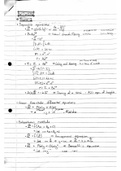Separable equations Study guides, Study notes & Summaries
Looking for the best study guides, study notes and summaries about Separable equations? On this page you'll find 90 study documents about Separable equations.
Page 3 out of 90 results
Sort by
This document contains all formulas for the module course WTW256
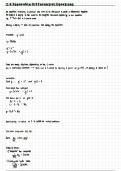
-
Separable Differential Equations | Calculus II Notes
- Summary • 3 pages • 2023
- Available in package deal
-
- R148,83
- + learn more
Defines differential equations, gives step by step examples on how to soble separable differential equations (both general and particular solutions) and initial conditions,
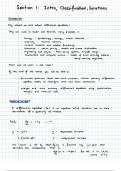
-
APMA 0350-Introduction to Differential Equations, Existence and Uniqueness, Numerical Methods, Autonomous Equations, and Separable Equations
- Summary • 25 pages • 2024
-
- R148,83
- + learn more
This is a summary of the basic ideas and concepts required for APMA 0350, which is a course offered at Brown University. It covers topics expressed in the title in-depth, in addition to a few other topics that are essential to know for this course.

-
Chemistry in Context Applying Chemistry to Society 9Th Edition -Test Bank
- Exam (elaborations) • 207 pages • 2023
- Available in package deal
-
- R601,26
- + learn more
1. The quantity 0.0000064 g expressed in scientific notation. A.6.4×106 g B. 6.4 × 10 ̄6 g C.6.4×107 g D. 6.4 × 10 ̄7 g Accessibility: Keyboard Navigation Bloom's Level: 3. Apply Chapter: 01 Section: 01.08 Subtopic: Scientific Notation Topic: Study of Chemistry Feedback: Negative powers of ten move the decimal to the left. 2. The quantity 8.7 × 105 g expressed in standard decimal notation. A. 0.000087 g B. 870.000 g C. 0.0000087 g D. 870,000 g Accessibility: Keyboard Navigat...
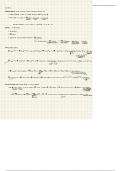
-
NEU Differential Equations and Linear Algebra Notes
- Class notes • 119 pages • 2024
-
- R288,54
- + learn more
Notes for Northeastern University's differential equations and linear algebra course throughout the entire semester (or diff eqs and lin alg in general). Differential equations topics include 1st order differential equations, 2nd order differential equations, homogeneous systems, non-homogenous systems, separable equations, mechanical vibrations etc. Linear algebra topics include Laplace transform, shifting theorem, convolution, matrices, systems of equations, eigenvalues, eigenvectors, etc. In...

-
Exam (elaborations) TEST BANK FOR The Chemistry Maths Book 2nd Edition By Steiner E. (With Solution Manual)
- Exam (elaborations) • 1116 pages • 2021
-
- R297,85
- + learn more
Exam (elaborations) TEST BANK FOR The Chemistry Maths Book 2nd Edition By Steiner E. (With Solution Manual) The Chemistry Maths Book Second Edition Erich Steiner University of Exeter without mathematics the sciences cannot be understood, nor made clear, nor taught, nor learned. (Roger Bacon, 1214–1292) 1 Contents 1 Numbers, variables, and units 1 1.1 Concepts 1 1.2 Real numbers 3 1.3 Factorization, factors, and factorials 7 1.4 Decimal representation of numbers 9 1.5 Variables ...
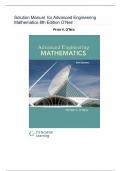
-
Solution Manual for Advanced Engineering.pdf
- Exam (elaborations) • 41 pages • 2023
-
- R176,68
- + learn more
Chapter 1 First-Order Differential Equations 1.1 Terminology and Separable Equations 1. The differential equation is separable because it can be written 3y 2 dy = 4x, dx or, in differential form, Integrate to obtain 3y 2 dy = 4xdx. y 3 = 2x 2 + k. This implicitly defines a general solution, which can be written explicitly as y = (2x 2 + k) 1/3 , with k an arbitrary constant. 2. Write the differential equation as dy x dx = −y, which separates as 1 1 if x /= 0 an...
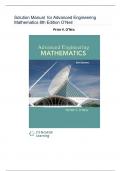
-
Solution Manual for Advanced Engineering.pdf
- Exam (elaborations) • 41 pages • 2023
-
- R148,83
- + learn more
Chapter 1 First-Order Differential Equations 1.1 Terminology and Separable Equations 1. The differential equation is separable because it can be written 3y 2 dy = 4x, dx or, in differential form, Integrate to obtain 3y 2 dy = 4xdx. y 3 = 2x 2 + k. This implicitly defines a general solution, which can be written explicitly as y = (2x 2 + k) 1/3 , with k an arbitrary constant. 2. Write the differential equation as dy x dx = −y, which separates as 1 1 if x /= 0 an...
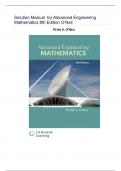
-
Solution Manual for Advanced Engineering.pdf
- Exam (elaborations) • 41 pages • 2023
-
- R176,68
- + learn more
Chapter 1 First-Order Differential Equations 1.1 Terminology and Separable Equations 1. The differential equation is separable because it can be written 3y 2 dy = 4x, dx or, in differential form, Integrate to obtain 3y 2 dy = 4xdx. y 3 = 2x 2 + k. This implicitly defines a general solution, which can be written explicitly as y = (2x 2 + k) 1/3 , with k an arbitrary constant. 2. Write the differential equation as dy x dx = −y, which separates as 1 1 if x /= 0 an...

-
Solution Manual for Advanced Engineering.pdf
- Exam (elaborations) • 41 pages • 2023
-
- R167,46
- + learn more
Chapter 1 First-Order Differential Equations 1.1 Terminology and Separable Equations 1. The differential equation is separable because it can be written 3y 2 dy = 4x, dx or, in differential form, Integrate to obtain 3y 2 dy = 4xdx. y 3 = 2x 2 + k. This implicitly defines a general solution, which can be written explicitly as y = (2x 2 + k) 1/3 , with k an arbitrary constant. 2. Write the differential equation as dy x dx = −y, which separates as 1 1 if x /= 0 an...

That summary you just bought made someone very happy. Also get paid weekly? Sell your study documents on Stuvia! Discover all about earning on Stuvia

